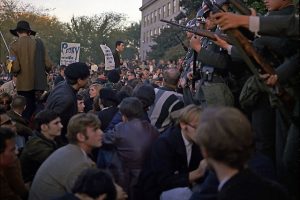Top 10 Revolutionary Artists of the 20th Century That Changed Art Forever
The 20th century was a wild ride for art—full of bold experiments, shocking ideas, and creators who refused to play by the rules. These ten artists didn’t just make pretty pictures; they shattered expectations, turning art into something strange, personal, and utterly unforgettable.
Take Pablo Picasso, for example. One day he’s painting delicate portraits, the next he’s chopping faces into jagged pieces with Cubism. Love it or hate it, you can’t unsee it. Then there’s Frida Kahlo, who turned her pain into surreal self-portraits—thorn necklaces, bleeding hearts, and all. Her work feels like reading someone’s diary… if the diary was also a fever dream.
Ever stared at a Salvador Dalí painting and wondered, “What was he on?” Melting clocks, lobster telephones—his bizarre visions still mess with our heads. Meanwhile, Andy Warhol made soup cans and Marilyn Monroe’s face into high art, proving that pop culture could be just as powerful as a Renaissance masterpiece.
And let’s not forget Wassily Kandinsky, who ditched realism entirely, painting explosions of color that felt like music. Or Marc Chagall, whose floating lovers and glowing fiddles made the ordinary look magical.
What’s crazy? Decades later, their work still sparks debates, memes, and even Halloween costumes. Whether it’s Picasso’s fractured faces or Warhol’s obsession with fame, these artists didn’t just follow trends—they invented them. Want more? Dive into the rebellious world of [20th-century American painters]—some names might surprise you.
1. Pablo Picasso: The Rule-Breaking Genius Who Changed Art Forever
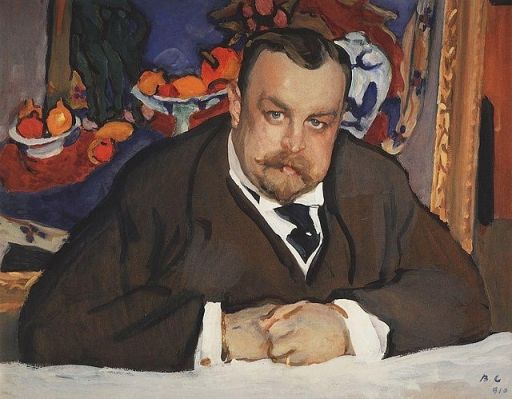
A Child Prodigy Who Painted Like a Master
Pablo Picasso didn’t just become an artist—he was born one. By age 7, he was already sketching better than most adults, thanks to his artist father, who handed him brushes instead of toys. At 13, he wowed the judges at Barcelona’s art academy by finishing an entrance exam in one day—a test that took others a month. By his late teens, he was already ditching formal training, saying, “Art schools? Too boring. I’d rather invent my own rules.”
Paintings That Shocked the World
Picasso didn’t just make art—he waged war on tradition. His Blue Period (1901-1904) drowned canvases in melancholy, while his Rose Period (1904-1906) flirted with circus performers and dreamy pinks. Then came the atomic bomb of modern art—Les Demoiselles d’Avignon (1907). Five women, sliced into jagged shapes, staring back like they’d just crashed a Renaissance ball. Critics called it “ugly.” History called it the birth of Cubism.
Then, in 1937, he dropped Guernica—a black-and-white scream against war, with twisted bodies and a dying horse. It wasn’t just a painting; it was a propaganda weapon, proving art could punch dictators in the gut.
The Man Who Invented Modern Art (And Stole All the Headlines)
Picasso didn’t just influence art—he rewrote its DNA. With Georges Braque, he shattered reality into Cubist puzzles, inspiring movements like Surrealism and Abstract Expressionism. But here’s the twist: he never stuck to one style. One day he’d paint a weeping woman, the next he’d sculpt a bicycle seat into a bull’s head.
Even his personal life was a spectacle—fiery love affairs, pet owls, and a habit of working in his pajamas. He once said, “It takes a long time to become young.” And at 91, he was still painting like a rebellious teen.
2. Wassily Kandinsky: The Lawyer Who Painted Music (And Invented Abstract Art)
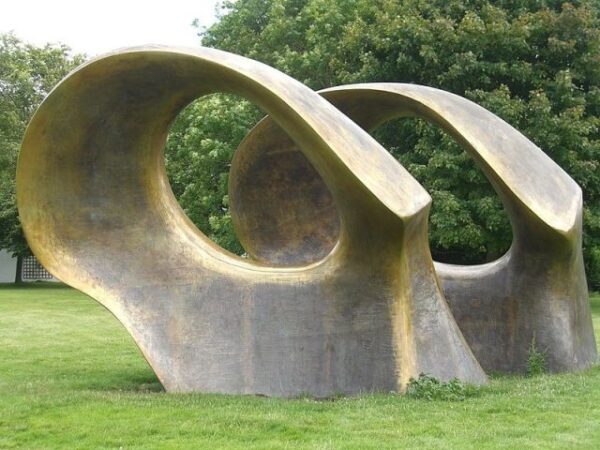
From Courtrooms to Canvases: A Radical Career Switch
Imagine ditching a successful law career to chase colors and shapes—that’s exactly what Kandinsky did. Born in Moscow in 1866, he had it all: wealth, education, and a bright future in law. But after seeing Monet’s Haystacks (which he mistook for a “mess of colors”), something snapped. At 30 years old, he abandoned everything, moved to Germany, and declared: “Art should make you feel, not just see.”
Paintings That Look Like Jazz Songs
Kandinsky didn’t just paint—he composed. His works weren’t about trees or people; they were visual symphonies:
- The Blue Rider (1903) – A horseback figure dashing through a dreamy landscape, kicking off his obsession with color as emotion.
- Composition VII (1913) – Chaos turned into harmony. This explosive masterpiece took 4 months of prep and 4 days of non-stop painting. Critics called it “madness.” He called it “art’s future.”
- Yellow-Red-Blue (1925) – Geometry meets emotion. Sharp lines clash with floating circles, like a jazz improvisation on canvas.
Fun fact: He had synesthesia—a rare condition where he heard colors and saw music. (No wonder his art feels like a playlist.)
The Man Who Made “Meaningless” Art Meaningful
Before Kandinsky, “good art” meant realistic portraits and landscapes. Then he dropped a bombshell: What if shapes and colors alone could tell a story? His 1911 book, On the Spiritual in Art, argued that art should be a spiritual experience, not just a pretty picture.
His wild experiments birthed abstract art, inspiring movements like Bauhaus and Expressionism. Even today, his work feels shockingly modern—like a century-old Instagram feed of bold, hypnotic visuals.
3. Kazimir Malevich: The Rebel Who Painted Nothing (And Changed Everything)

The Dropout Who Redefined Art
Born in Kyiv in 1879, Kazimir Malevich was the art world’s ultimate rule-breaker. His father wanted him to be a factory worker—but Malevich had other plans. After failing to get into the Moscow School of Painting (irony alert), he taught himself, mixing peasant folk art with radical modern ideas. By 1915, he dropped a bomb on the art world: Black Square—a painting that was literally just a black square. Critics gasped. The public laughed. Malevich just smirked.
The Most Controversial Paintings in History
Malevich didn’t just push boundaries—he erased them:
- Black Square (1915) – A perfect black void. Some called it a joke. Others, the “zero point” of art. (Fun fact: It cracked and yellowed over time—Malevich would’ve loved that it “evolved.”)
- White on White (1918) – A white square floating on a white background. The ultimate “Is this even art?” debate starter.
- Suprematist Composition (1916) – Geometric chaos. Rectangles and lines dancing in space like a cosmic board game.
He called this style Suprematism—art stripped down to pure feeling, no objects allowed. (Take that, Renaissance painters.)
The Prophet of “Art Without Meaning”
Malevich didn’t just paint—he declared war on reality. While others painted landscapes and portraits, he insisted:
- “Art should transcend the visible world!”
- “A square isn’t just a shape—it’s a universe of emotion!”
His ideas were so radical that even the Soviet government got nervous. They banned abstract art, calling it “bourgeois nonsense.” Malevich responded by… painting portraits again (but with a hidden smirk).
4. Salvador Dalí: The Mad Genius Who Made Melting Clocks Cool
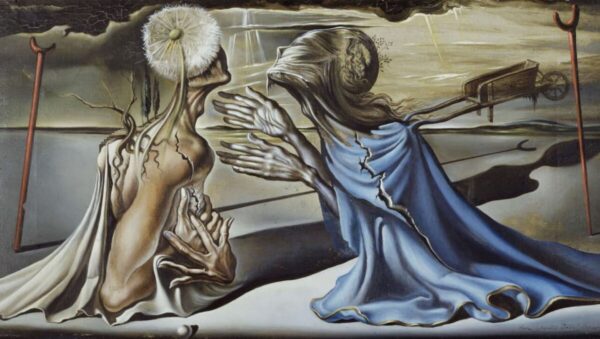
The Boy Who Was Born… Twice?
Salvador Dalí didn’t just enter the world—he staged it. Born in Figueres, Spain (1904), he was named after his dead brother (yes, really). His parents told him he was the reincarnation of his sibling, which might explain why he grew up believing reality was… flexible. By age 6, he was drawing rotting donkeys. By 10, he declared himself a genius. And by 20, he got kicked out of art school for telling his professors: “I am infinitely more talented than all of you.” (Spoiler: He wasn’t wrong.)
Paintings That Melted Minds (And Time Itself)
Dalí didn’t just paint dreams—he weaponized them:
- The Persistence of Memory (1931) – Those droopy clocks weren’t just weird; they were a middle finger to physics. (“Time? Pfft. It’s as solid as Camembert in the sun.”)
- Dream Caused by the Flight of a Bee… (1944) – A tiger leaping from a fish, a gun firing a bee, and his wife Gala floating mid-scream. Basically, your brain on 3 a.m. insomnia.
- The Temptation of St. Anthony (1946) – A parade of spindly-legged elephants carrying giant obelisks. Because why not?
Fun fact: He called his method the “paranoiac-critical technique”—basically, hallucinating on purpose to fuel his art. (No drugs needed—just pure, unhinged imagination.)
The Surrealist Who Out-Surrealisted Everyone
While other artists played nice with reality, Dalí set it on fire:
- He wore a deep-sea diving suit to a lecture (and nearly suffocated).
- Owned a pet ocelot named Babou (which he walked on a leash in Paris).
- Designed a lobster telephone (because regular phones were too boring).
His motto? “I don’t do drugs. I am drugs.” And his legacy? Proving that art could be shocking, hilarious, and profound—all at once.
5. Henri Matisse
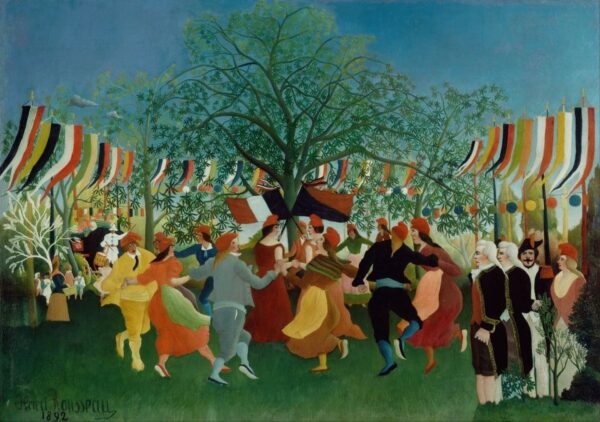
Biography of Henri Matisse
Henri Matisse was born on December 31, 1869, in France. Initially studying law, Matisse turned to art after an illness led him to paint. His first teacher, Gustave Moreau, introduced him to the importance of color and form, and Matisse soon moved away from traditional techniques, inspired by the works of Manet and Japanese prints.
Key Works by Henri Matisse
Matisse’s notable works include Dance and Music, commissioned by Sergei Shchukin. These paintings became symbols of Fauvism, a movement known for its bold colors and simplified forms.
Matisse and Fauvism
Matisse was a leader of the Fauvist movement, which broke away from traditional methods of representation in favor of pure color and form. His work has had a lasting influence on modern art.
6. Marc Chagall: A Visionary Artist
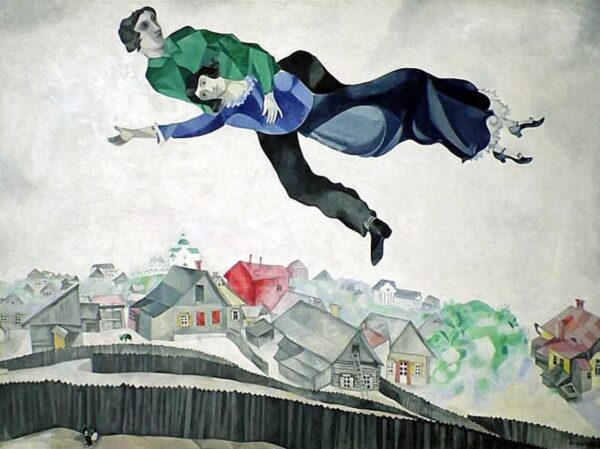
Early Life and Education
Born Moisey Khatskelevich in 1887 in Vitebsk, Belarus, Marc Chagall was deeply influenced by Jewish culture and folklore. He began his artistic journey at the Yudel Pen Art School before advancing his studies in St. Petersburg under the guidance of Lev Bakst.
Famous Works
Chagall’s renowned paintings include Above the City, Me and My Village, and The Walk. His art, a fusion of reality and fantasy, reflects his profound connection to his heritage and the deep love he held for his wife, Bella.
Chagall’s Unique Style
Chagall’s work is distinguished by its vibrant colors, dreamlike compositions, and surreal imagery. Blending elements of folk art with modernism, his paintings often feature floating figures, animals, and poetic symbolism. This distinctive style has solidified his place as one of the most beloved artists of the 20th century.
7. Marcel Duchamp
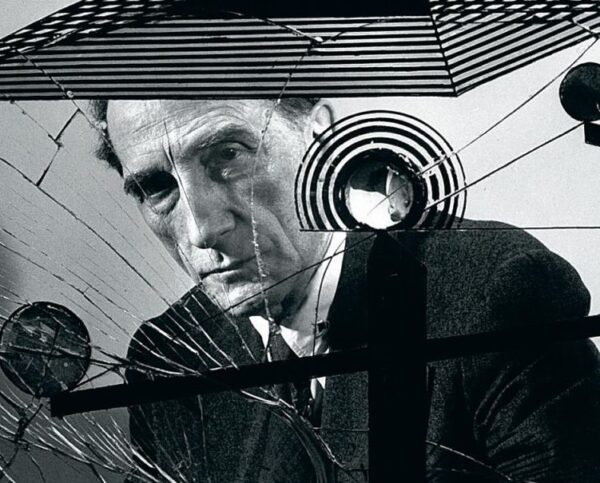
Marcel Duchamp (1887–1968) was a groundbreaking French-American artist whose radical ideas redefined modern art. A central figure in Dada and Surrealism, he challenged traditional notions of art, authorship, and aesthetics, influencing generations of artists.
Key Contributions & Ideas
- Readymades – Duchamp’s most revolutionary concept involved selecting ordinary manufactured objects (like a urinal or a bicycle wheel) and presenting them as art, questioning the role of the artist and the necessity of craftsmanship.
- Fountain (1917), a signed urinal, remains one of the most controversial artworks in history.
- Other readymades: Bicycle Wheel (1913), Bottle Rack (1914).
- Anti-Art & Dada – Rejecting conventional beauty, Duchamp embraced absurdity and irony, aligning with the Dada movement’s anti-establishment ethos.
- Kinetic Art & Optical Experiments – Works like Rotary Demisphere (1925) explored motion and perception, influencing later Op Art.
- Conceptual Art Pioneer – He prioritized ideas over visual appeal, paving the way for Conceptual Art (e.g., The Large Glass, an unfinished work accompanied by cryptic notes).
Major Works
- Nude Descending a Staircase, No. 2 (1912) – A Cubist-Futurist painting that caused a scandal at the 1913 Armory Show.
- L.H.O.O.Q. (1919) – A defaced Mona Lisa postcard, mocking art’s sacred status.
- Étant donnés (1946–66) – A secret, immersive installation revealed after his death.
Legacy
Duchamp’s irreverence toward tradition inspired movements like Pop Art (Warhol), Minimalism, and Performance Art. His belief that “art is whatever the artist says it is” remains a cornerstone of contemporary art.
8. Frida Kahlo: The Woman Who Turned Pain Into Power (And Became a Legend)
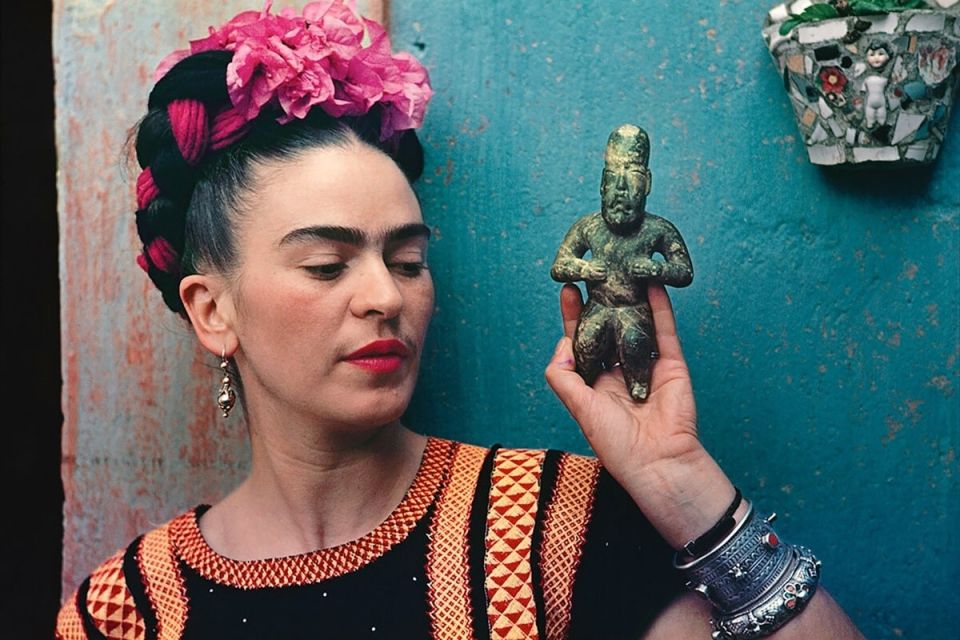
A Life Written in Scars
Frida Kahlo didn’t just live—she survived.
- Polio at 6 left her with a limp.
- A brutal bus crash at 18 shattered her spine, pelvis, and ribs—piercing her with a metal handrail like some grotesque fate.
- 32 surgeries. Years in bed. A body held together by corsets.
And yet—she painted. Not flowers or sunsets, but herself: bleeding, broken, defiant. “I paint my own reality,” she said. And what a reality it was.
Self-Portraits That Scream, Whisper, and Defy
Her canvases weren’t art—they were diaries in oil:
- The Broken Column (1944) – A split-open Frida, her spine a crumbling Ionic column, nails studding her skin like a martyr. No pity. Just a steady, tearless gaze.
- The Two Fridas (1939) – One Frida in a Victorian dress (heart intact). The other in Tehuana garb (heart ripped open, scissors in hand). A duel between who she was and who she had to become.
- Henry Ford Hospital (1932) – Floating in a bloodstained bed, surrounded by a fetus, a pelvis, a snail. The painting she made after her miscarriage. “They thought I was a Surrealist,” she scoffed. “I didn’t paint dreams. I painted my own damn life.”
The Original Feminist Icon (Before Hashtags Existed)
In 1950s Mexico, women were expected to be decorative. Frida was a grenade:
- She wore men’s suits and Tehuana dresses—whichever pissed off the patriarchy more that day.
- Painted her unibrow and mustache with pride (“I won’t trim myself to please you”).
- Had affairs with both men and women (including Trotsky and Josephine Baker).
Her art screamed what women weren’t allowed to say: “I hurt. I rage. I exist.”
9. Andy Warhol: The Man Who Turned Soup Cans Into Art (And Became More Famous Than The Stars He Painted)
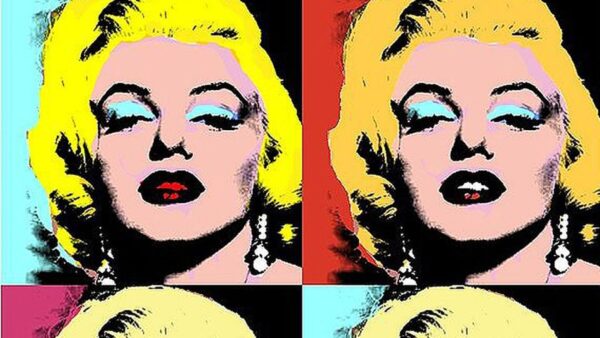
From Sickly Kid to King of Cool
Andy Warhol wasn’t born glamorous—he invented it.
- Grew up poor in Pittsburgh, a shy, bedridden kid with blotchy skin (he later called it his “first pop art”).
- Started as a shoe ad illustrator, doodling for Vogue and Glamour—until he realized: “Why draw for brands when I can make brands the art?”
- By the 1960s, he was the pope of Pop Art, ruling NYC from his silver-coated studio, The Factory, where drag queens, rock stars, and socialites lined up to be “Warholized.”
Art That Wasn’t “Deep”—And That Was the Point
Warhol didn’t worship masterpieces—he worshipped the mundane:
- Campbell’s Soup Cans (1962) – 32 identical canvases. Critics sneered: “Is this a joke?” Andy shrugged: “No. It’s lunch.”
- Marilyn Diptych (1962) – Monroe’s face, copied, smeared, and repeated like a fame glitch. (Painted right after her death—Warhol called it “the perfect product, finally on sale.”)
- Brillo Boxes (1964) – Piles of fake soap pads. “Is it art? Is it a supermarket? Does it matter?”
His genius? Making repetition feel revolutionary.
The Prophet of the “15-Minute Fame” Era
Before influencers, hashtags, and viral fame—there was Warhol. He predicted our obsession:
Filmed people sleeping, eating, being boring—and called it art. (Sound like YouTube vlogs?)
“In the future, everyone will be famous for 15 minutes.” (He was way off—try 15 seconds now.)
Turned himself into a brand—white wig, deadpan stare, same jacket every day.
10. Jackson Pollock: The Paint-Slinging Rebel Who Redefined Art
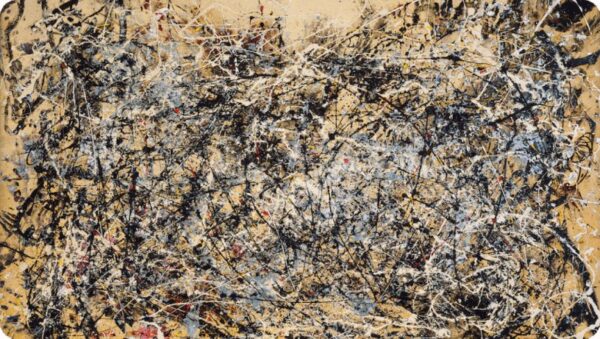
The Original Art Wild Child
This Wyoming cowboy’s son didn’t make art—he battled it into existence.
- Flunked art school for “lack of talent” (later sold a painting for $140M)
- Worked in overalls like a construction worker, turning barn floors into canvases
- Stabbed paint cans with knives: “Let the paint decide where it wants to go”
Iconic Works That Shook the Art World
- No. 5, 1948 – Sold for $140M in 2006 (then a world record)
- Autumn Rhythm – A 10ft-wide storm of paint resembling musical notation
- Lavender Mist – 238 interwoven paint trails creating hypnotic chaos
The Revolution He Started
Pollock turned painting into full-contact sport:
Made American art surpass European tradition for the first time
Laid canvases on the floor, dancing around them like a shaman
Invented “drip technique” that influenced 60+ years of art
How 20th Century Artists Broke the Rules (And Why It Still Matters Today)
Think about the last time you scrolled through Instagram and stopped dead at a post that made you say, “Wait… what is this?” That feeling—the shock, the curiosity, the itch to figure it out—is exactly what artists like Picasso and Frida Kahlo were after. They didn’t just paint pretty pictures; they hacked how we see the world.
Picasso’s Cubism, for example, smashed faces and guitars into jagged puzzle pieces. At first, people hated it. (One critic called it “a pile of broken glass.”) But that was the point—it forced viewers to rethink reality. Meanwhile, Kahlo turned her own pain into surreal, spine-tingling self-portraits, blending Mexican folklore with raw emotion. These weren’t just paintings; they were rebellions.
Here’s the wild part: their ideas still pop up everywhere today. Ever seen a meme that remixes classic art? Or an ad with chopped-up, abstract visuals? That’s the 20th century’s art revolution still messing with us. These artists proved that creativity isn’t about following rules—it’s about torching the rulebook and seeing what happens next.
Next time you see something bizarre online (a banana duct-taped to a wall, anyone?), tip your hat to the OG rule-breakers. Because the best art—then and now—doesn’t just sit there. It grabs you by the collar and shakes you.
The 20th century’s art weirdos didn’t just make “art.” They turned it into a conversation that’s still shouting at us—from galleries to your TikTok feed.













